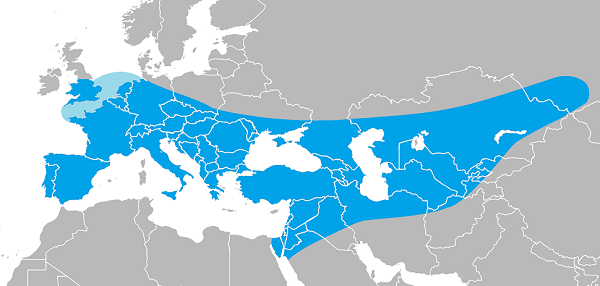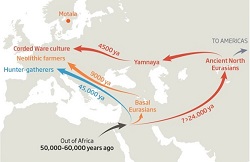Whatever wave of migration we look at, someone was already there. Colin Barras in the New Scientist (paywalled) takes a look at the three ancestral waves of migration that founded Western civilisation.
First were the hunter-gatherers. Then came the farmers. These were followed by the Yamnaya, originating from herders on the steppes north of the Black Sea, who brought the horse and the wagon, and the Indo-European language that predominates in Europe, except for Basque, Estonian, Finnish and Magyar (Hungarian).
Already there, in the very beginning, were the Neanderthals. We were told in Neanderthals r us that, other than modern Africans, we carry between 1 and 4 per cent of our genes from Homo neanderthalensis. Here’s the range of Homo neanderthalensis:

North of them would have been ice.
We know that at least some of the Neanderthals had pale skin and red hair. The newcomers had darker skin and blue eyes. They:
- flourished in Europe’s forests, hunting the woolly rhinoceros, bison and the like that lived there. Long before farmers tamed cows and sheep, these early Europeans made friends with wolves. Like the Neanderthals, some of them lived at the mouths of caves – sometimes the very same caves – which they lit and heated with roaring fires. Like them, they ate berries, nuts, fish and game.
They also
- had artistic sensibilities, expressed in vast murals and using musical instruments like bone flutes and bullroarers. Surviving murals tell us about the large game they hunted. Perhaps most significantly, they show that the people were keen observers of the world they lived in, and capable of abstract thought.
Not all lived in caves, some built rudimentary housing structures. For 30,000 years they had Europe to themselves. Then about 9000 years ago the Neolithic farmers arrived from the Middle East, who sowed seeds and domesticated animals, such as cows and sheep. Evidence of cheese-making dates from at least 7,500 years ago in Poland. Villages became a much more common.
They brought closer settlement, mass violence and war.
With the farmers, or soon thereafter, the genes responsible for fair skin swept through Europe. Humans living at higher latitudes typically evolve pale skins so they can absorb more UV rays and make vitamin D. The farmers also also had dark eyes. They had lived long enough in separation in the Middle East to develop their own characteristics.
The Yamnaya were cattle herders of the Eurasian steppes. Until about 5500 years ago their settlements clung to the river valleys of the Eurasian steppe, where they had easy access to the water they and their livestock needed. Then they domesticated the horse and adopted the wheel to make wagons, which allowed them to move out onto the plains.
They were very proficient in military arts.
From the post Deep origins:language, David Anthony thinks the core time for the development of the Indo-European language was 4000 to 3000 BCE, with an early phase that might go back to 4500 BCE and a late phase that may have ended around 2500 BCE. That’s about 4500 years ago. At that time according to Barras the Yamnaya began to spread throughout Europe. Conquer they certainly did, but not necessarily replace. Fraternisation and genetic mingling occurred.
This image shows the broad waves of migration:

The resulting genetic mix varies:

Estonia is curious in that it has a high penetration of Yamnaya genes but retained its original language. Anthony says this happens when the population do not accept the culture of the conquering overlords. The hunter-gatherer residue is strongest there too.
Of course there has been a lot of mixing since then. In the language post I used this diagram to show the main disruptions to the Roman Empire, especially by the Germanic tribes out of the north:

In the long run I guess that we are heading towards greater genetic homogeneity. Certainly populations need many generations of separation to develop distinctive characteristics.
Last year in Pushing back the African exodus I looked at recent research showing that the movement out of Africa pre-dated considerably the 45,000 year mark. It seems most of that movement went east, away from the Neanderthals.

